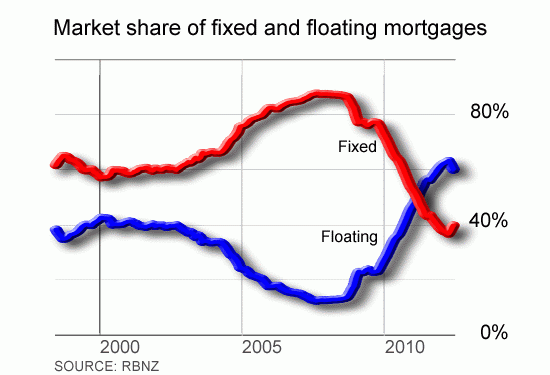
By Gareth Vaughan
ASB's annual results this week will give an early indication as to whether borrowers' shifting back to fixed-term mortgages from floating, or variable, rate loans is helping reverse a strong upswing in net interest margins at the big four New Zealand banks.
ASB, alongside its parent Commonwealth Bank of Australia (CBA), is due to announce financial results for the year to June 30 on Wednesday. Separately, BNZ's parent National Australia Bank (NAB) issued its third quarter trading update today saying bad and doubtful debts on business loans drove a fall in BNZ's quarterly earnings. And on Friday the ANZ Banking Group, owner of New Zealand's ANZ and National banks, will release its third quarter trading update. The Westpac Group, which along with NAB and ANZ has a September 30 financial year balance date, won't be issuing a third quarter trading update.
In CBA's third quarter trading update in May CEO Ian Narev said ASB had "maintained strong operating income in an environment of increased funding costs, supported by a continuing focus on cost management and productivity improvement. Margins were steady over the period in a competitive environment."
This followed ASB, in February, reporting record half-year net profit of NZ$372 million, up NZ$89 million, or 31%, from NZ$283 million in the first-half of its previous financial year. ASB's other key profitability measures all also showed improvement in the interim results, with return on shareholders' equity rising to 21.2% from 17.2% in the June 2011 year, return on total average assets up to 1.2% from 0.9%, net interest margins up 11 basis points to 2.19%, and total operating expenses as a percentage of total operating income down to 40% from 44.9%. Ordinary dividends were lifted to NZ$340 million from NZ$80 million in the six months to December 2010.
Return to fixed mortgages underway
At 2.19% at the end of 2011, ASB's net interest margins were up 62 basis points from 1.57% in the depths of the global financial crisis at June 30, 2009. Like its major rivals' net interest margins, ASB's have been bolstered over the past couple of years by customers' switching from fixed-term to floating rate mortgages. Banks do better out of floating mortgages because the margin between the variable rate and short end of the yield curve, such as three month bank bills, is higher than the margin between the swap rate and fixed rate mortgages.
Reserve Bank data shows the industry wide percentage of mortgages floating, by value, fell to 59.9% at the end of June from a record high of 63% at the end of April this year. That compares with the fixed high point of 87.5% as of August 2007, and 75% at November 2009 when the big move to floating kicked off.
At the end of June, the total value of banks' on-balance sheet mortgages floating was NZ$104.246 billion, down NZ$4.57 billion in just two months, with the total value of on-balance sheet fixed term mortgages up NZ$5.88 billion to NZ$69.383 billion. See more on the fixed v floating data here.
As of December 31, 2011, ASB had 63% of its home loan portfolio on floating rates, up from 59% at June 30 last year. Of its business loans, 87% were on floating rates, up from 86%.
In their interim results ANZ, BNZ and Westpac also revealed solid rises in net interest margins. ANZ disclosed a New Zealand business net interest margin and a New Zealand geography one. The former rose 12 basis points to 2.65% and the latter was up 10 basis points to 2.50%. Westpac's net interest margin rose 6 basis points to 2.43%, and BNZ's rose 6 basis points to 2.41%.
BNZ CEO Andrew Thorburn told interest.co.nz in May that net interest margins were now back to a sustainable level and although they might fall a bit, a 2.30% to 2.45% range was likely to be the long- term average. Meanwhile, after the release of the ANZ Banking Group's half-year results, CEO Mike Smith told interest.co.nz he expected the group's New Zealand margins to "plateau".
The New Zealand subsidiaries have been stand outs in their parents financial results of late, helped by the benefits flowing through from the customer switch to floating mortgages from fixed-term ones whereas floating mortgages have long been the more popular option in Australia.
ASB lending expected to rise 5%
Analysts at Macquarie expect CBA to report new record annual net profit after tax of A$7.1 billion, up 4.1% year-on-year, but a five basis points half-on-half drop in net interest margins to 2.10%. Meanwhile, Bank of America Merrill Lynch's Australian based banking analysts Matthew Davison, Nicole Mehalski and Frank Podrug are forecasting 5% lending growth from ASB, up from -8% in the year to June 2011.
The Bank of America Merrill Lynch team says key themes from the bank reports will be underlying growth, margins and forward looking asset quality measures.
"Repricing and an easing in term deposit pressures will start to come through in margins (though very little will show in CBA’s second half) but this may be offset by softness at the institutional end, and the absence of NZ margin support. We expect bad debt charges to be fairly steady, but will be looking at how the SME segment, along with trends in Queensland, are shaping up. Trading income is unlikely to be a big swing factor in these updates."

This article was first published in our email for paid subscribers this morning. See here for more details and to subscribe.

We welcome your comments below. If you are not already registered, please register to comment.
Remember we welcome robust, respectful and insightful debate. We don't welcome abusive or defamatory comments and will de-register those repeatedly making such comments. Our current comment policy is here.